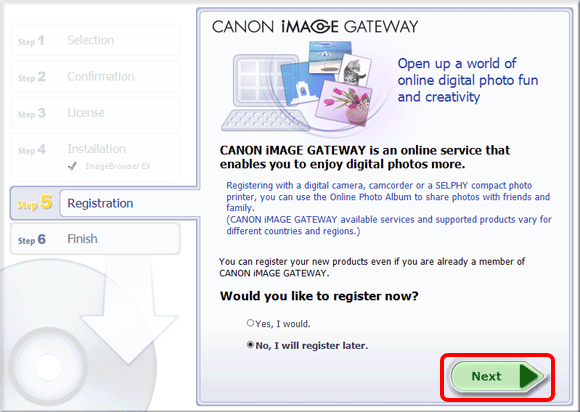
- #CANON IMAGE GATEWAY REGISTER MEXICO FULL#
- #CANON IMAGE GATEWAY REGISTER MEXICO PRO#
- #CANON IMAGE GATEWAY REGISTER MEXICO ISO#
Raw files are compressed but lossless, and bring out the best in the image results from the camera.

Other features of note are an articulating LCD and built-in GPS, and of course the requisite Wi-Fi with NFC and Bluetooth. Given those specs one might expect a built-in flash, but one would be wrong.
#CANON IMAGE GATEWAY REGISTER MEXICO PRO#
There are some other items that point to the Canon EOS 6D Mark II being an enthusiast rather than a pro model: the shutter speed tops out at 1/4000 second it has a low-pass filter and while the viewfinder is bright and super-clear and delivers more information than a glimpse can handle (it’s customizable and you can leave it all in there or select just those parameters you consider vital), it covers 98 percent, not 100 percent, of the field of view.
#CANON IMAGE GATEWAY REGISTER MEXICO FULL#
(Note: You need to press the Live View button to get it going-there is no auto on or off when viewing through the eyepiece with Live View on: it simply stays on until you push the Live View button again.) It’s great for video recording, which, by the way, is Full HD (1080/60p) and not 4K. Nevertheless, Live View is easy to evoke and a pleasure to use, and does provide exposure simulation and 100 percent coverage. In Live View the max framing rate is 4.5 frames per second (fps) while viewfinder shooting goes to a moderate but still rapid enough 6.5 fps. The AF system is versatile and responsive, with 45-point all cross-type AF sensors and five area selection modes, so you can match and track with your AF options for virtually any subject or scene.Īdded to that is Canon’s Dual Pixel CMOS AF setup for Live View shooting.
#CANON IMAGE GATEWAY REGISTER MEXICO ISO#
(Some effects, like HDR, panning, and scene modes, limit the high end to 12,800 or less: Bulb shooting is limited to ISO 400.) ]Ī number of admittedly higher-end full-frame cameras deliver higher resolution, but Canon has, in my opinion, opted to make the 6D Mark II more accessible (and affordable) to their intended audience. The Canon EOS 6D Mark II contains a 26.2MP full-frame CMOS sensor that can deliver an ISO range of 100 to 40,000 with a push (gain) available to EI 102,400. More on this in the field test to follow. If you’re not hip to that scene, you can still use the labeled buttons on the body (ISO, drive, etc.) or push the Menu button and make changes via the multi-controller in typical style. You can use the Canon 6D II’s touch controls for camera setup (formatting, Image Quality settings, Custom Functions, etc.) via the Menu, or with the “Q” button, which sits right above the multi-controller, for quickly selecting exposure setups, white balance, exposure compensation, etc.

You can slide, too: for example, for exposure compensation, or ISO and other controls, evoke the scale and then slide your finger along it to make a change. You can even pinpoint focus on the subject and release the Canon 6D II’s shutter by pressing via the touch method. (Shutter speed was 1/640 second at ISO 100.) Photos © George Schaub This turned out to be a great way to do vertical shots using the LCD. When I had the composition I wanted I simply touched the LCD on the center red blossom with my right hand index fingertip: the camera then confirmed focus and made the exposure. I cradled the camera around my left hand, with my fingers around the lens barrel, and opened the LCD so it rested on my wrist. I opened the lens to f/4 to yield a soft background and set the focal length at 70mm: this shot was made with Evaluative metering. I gave “touch shutter” a tryout on this close-up to see how it would work for a low-angle shot. This mimics settings you might make with the still included and numerous buttons, multi-controller ring, and command dial, but with touch control you simply press your finger on the option on the LCD and “touch” the desired setting. But if you haven’t swapped models in a while, or haven’t handled the company’s EOS 80D, one of the 6D Mark II’s hallmarks is a touch command setup.

The Canon 6D Mark II’s layout will be familiar to most who have worked with a DSLR.

Read what I thought of the Canon 6D II in this review. Packed with pro and enthusiast features alike, the Canon 6D Mark II is a thoroughly modern DSLR that incorporates the latest technology and a navigational setup that makes moving through and selecting from its many options a breeze. Along with touch control, the EOS 6D Mark II body has all the familiar Canon buttons and dials for setup and control, as well as an LED and in-viewfinder readout for choosing and changing parameters, an appreciated “redundancy” that aids in making settings under lighting conditions that might make working solely from the LCD difficult.


 0 kommentar(er)
0 kommentar(er)
